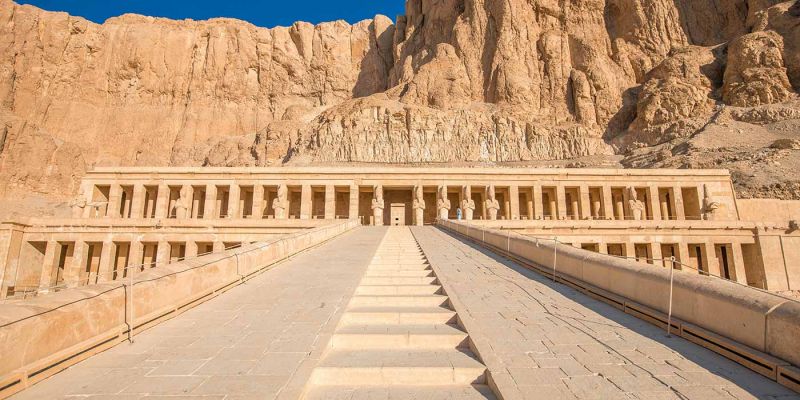Temple of Hatshepsut
Hatshepsut temple is a reflection of the mortuary temple of Mentuhotep II and was constructed alongside that 11th dynasty structure. Know more information about Temple of Hatshepsut!
Where is the Mortuary Temple of Hatshepsut?
The Mortuary Temple of Hatshepsut is located on the West bank of the Nile in Luxor. In terms of visual impact from afar, there is no rival to Hatshepsut’s Temples. The unique multi-tiered structure nestled up against the limestone cliffs at the shoulder of the river valley is a truly stunning sight. The uniqueness of its layout mirrors that of the pharaoh responsible for building it.
When was Hatshepsut's temple built?
The temple of Queen Hatshepsut was built 1470 BCE.
Hatshepsut was the only female pharaoh in the history of Ancient Egypt. She came to power during the New Kingdom after the death of her father, Tuthmose I, and her half-brother and husband, Tuthmose II, who succeeded her father on the throne.
She originally served as queen-regent to her husband's son by another wife, Tuthmose III, but seized the throne from him and managing to hold onto power until her death. However, Hatshepsut’s status as the only female to rule Egypt is not the only reason for her fame.
She was also a very successful pharaoh. She ruled over an era of peace and prosperity, expanding lucrative trade routes to the land of Punt in the south.

This accomplishment is immortalized in the relief carvings at her temple. She also contributed significantly to many temples, including Karnak. The temple was in ruins when it was discovered in the mid-19th century, having been heavily vandalized by Tuthmose III after he assumed the throne, presumably because Hatshepsut had kept him from power.
The site was also used as a monastery during the early centuries AD, which probably contributed to its deterioration. As a result, it has been heavily restored.
Most of the columns are not original and much of the relief paintings have not been well preserved. For this reason, the temple can be a bit disappointing close-up, especially given its popularity with tour groups.
This accomplishment is immortalized in the relief carvings at her temple. She also contributed significantly to many temples, including Karnak.

It developed over a period of 1500 years, added to by generation after generation of pharaohs and resulting in a collection of temples, sanctuaries, pylons, and other decorations that is unparalleled throughout Egypt.
While the height of its importance was during the New Kingdom and famous pharaohs such as Hatshepsut, Tuthmose III, Seti I and Ramesses II all contributed significant additions to the complex, construction continued into the Greco-Roman Period with the Ptolomies, Romans, and early Christians all leaving their mark here.
Temple Of Karnak Complex:
Karnak is divided into three compounds: the precinct of Amun, the precinct of Mut, and the precinct of Montu; however, for most visitors the largest of these, the precinct of Amun, is enough. Its complicated layout alone dwarfs every other site that you will visit in Egypt.
The precinct of Amun contains all of the most famous sections of the Karnak complex, including the dizzying Great Hypostyle Hall. This hall of 134 massive columns is one of the most impressive places in all of Egypt. Going into the detailed description of the different elements that make up the complex is a near endless task that we will leave to a tour guide.
Instead, we will simply suggest that you allow plenty of time to explore this huge complex and admire the many impressive sights within it. Imagine how awe-inspiring it must have been over 2000 thousand years ago when these huge structures were newly constructed.
